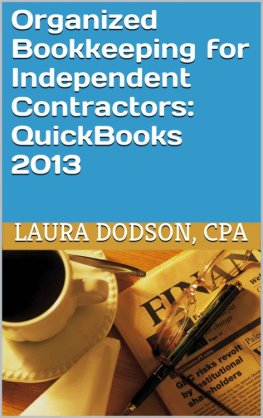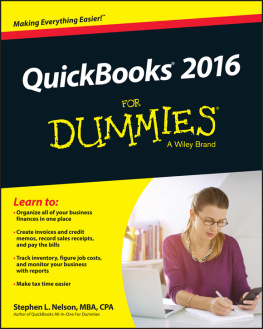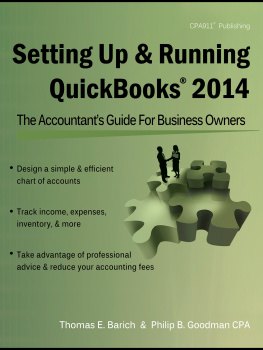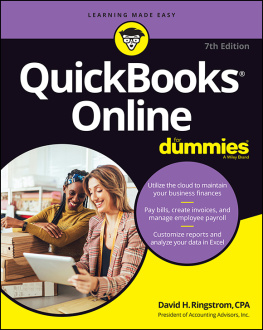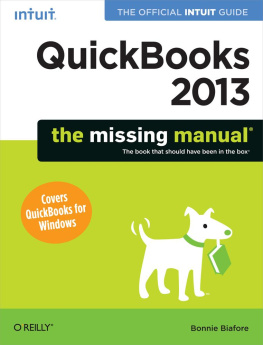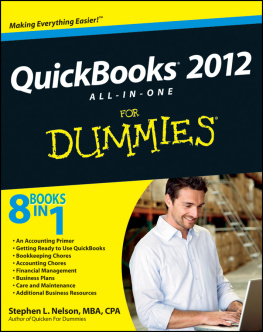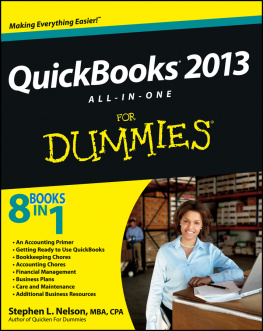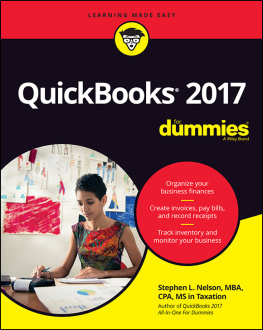Freelance or IndependentContractors are people who contract to provide services to an individual oranother business. As the workplace becomes more flexible and workers want totake part in that bounty, the subcontractors have been increasing in numbers. Some companies cant afford or justify having a full time specialist on thepayroll. Graphic Design, Writing, Web Design, and other creative crafts aregreat examples of traditional indedepent contractors.
There are isa three legged stool for any business, even if you have joined the everexpanding independent contractor workforce, this applies to your business aswell.. The first one leg of the stool is Marketing or Customer Service, thesecond leg is Operations, and the third leg is Financial or Accounting. Whenany of the legs are damaged or missing, a business suffers or stumbles a bit. Imagine a business who never billed their customers, for instance. This bookfocuses on the Financial or Accounting leg of the stool.
This bookfocuses on the bookkeeping needed for an independent contractor. Someindependent contractors are pretty close to employees and receive a 1099 at theend of the year. In spite of having most expenses paid for by the customerthere is room for additional tax savings by keeping close attention tooperating expenses. In addition, independent contracting can be a steppingstone to expanding to a traditional full service business with employees. Thereare additional complexitites to expanding from being a solopreneur to havingemployees and a more complex business model. There are additional toolsavailable to the those who need to hire people near the end of the book.
There is agood chance that youve already started your business and have had customers. Ifyou are running a business the one who knows your business best, is yourself. Who are your customers, what do they want from your company? Are you providingthat at a price that people want? Have you scoped out the competition? Whatare you doing about it?
Accountingand Bookkeeping can be used to help with those questions. Once the informationis summarized, its is easier to see trends and opportunities. Budgets, numbercrunching and financial statements are important tools in building a successfulplan and business.
Whatis an Independent Contractor?
An IndependentContractor is a person or a small company that provides services to otherpeople, businesses or non-profits. Typically, an independent contractor is ahighly skilled professional whose skills are in high demand. However, theworker finds it more profitable to be a hired gun for specific projects thanthat has a short term time span. They often find more satisfaction in theircareer if they have a variety of projects.
Delicious andtempting dreams of endless mounds of money do tempt some people to open abusiness. However, 50% of new businesses close in a year. Before putting downa deposit on that new yacht, its best to be prepared with the basics ofrunning a business.
Some changesfrom being an employee:
Benefits arenot covered by an employer: Medical Insurance, Liability Insurance andRetirement Account allocations are new expenses. Make sure you research these items;it can be more expensive that you think to purchase medical insurance for afamily of five.
In the futureyou will have to purchase your own tools, computers and other officeequipment. This may include a business website, internet connections, suitablechairs, and other things that previously been provided by an employer.
Work placeconsiderations: Where will you be working from?
A CoffeeShop? Most people start here, but remember, that electrical supplies arelimited, its expected that you continue to purchase food during the day, andnot all coffee houses have comfortable chairs.
At thebusiness that hired your company? This has some benefits of lower costs, beingon site, and building a relationship with the business owner. However, somehave reported that their schedule becomes less flexible, they are treated likean employee, and they receive constant interruptions.
At your homeoffice? Working from home can have great benefits. However, some havereported that their social circle shrinks and they need a separate place tohang their hat.
Renting asmall office? There are traditional offices for space as well as day rentalsof office space in business accelerators. Try each one out and see what fitsyour work style. Ive seen everything from quiet cubes with acres of quiet toraucous rooms of desks where people are two or less feet from each other.
Chaostheory: My experience is the independent contractor faces more uncertaintythan employees. Usually they are the first to be hired or fired. Their highercompensation amounts can attract the red pen of the CFOs budget cutting itemat a moments glance. It pays to be prepared and ready to act.
EntitySelection
One of thefirst decisions that you will have is to decide which business structure that youwant. Each business is slightly different and you will have this business typefor years, so take your time to decide between the different options.
SoleProprietorships: Thisbusiness type is owned by one person and is tied to their social security number. The owner is entirely responsible for the debts and liabilities of thebusiness. The personal liability part sounds a bit scary, but the vastmajority of businesses are of this type. 1040 and Schedule C, plus additionalschedules for Self-Employment Tax, Depreciation, and others as needed.
Partnerships: Two or more people have formed anagreement to run and operate a business. Each partner is separately liable forthe debts of a business. A Partnership Agreement may take several differentforms. Its highly recommended to hire an attorney to help with the contract. The federal taxes are computed on the 1065 and the profits flow through to therespective partners through the K-1s from the 1065.
LimitedLiability Company (LLC): Thisis an extremely popular form of company. The business structure can be similarto a Partnership or a Sole-Proprietorship, except the owner liability protectionis stronger. One of the special parts of an LLC is that you can re-class itwith the IRS to be an S-Corporation or a C Corporation. Once you do that, thebusiness will have to follow the rules for S-Corporations or C-Corporations.

